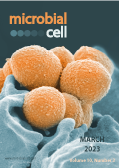Table of contents
Volume 10, Issue 3, pp. 49 - 77, March 2023
Cover: A colorized scanning electron microscope image of Group A Streptococcus (orange) during phagocytic interaction with a human neutrophil (teal); image by the National Institute of Allergy and Infectious Diseases (NIAID), USA; image modified by MIC. The cover is published under the Creative Commons Attribution (CC BY) license.
Enlarge issue cover
The metabolites of lactic acid bacteria: classification, biosynthesis and modulation of gut microbiota
Huang Tang, Wanqiu Huang and Yu-Feng Yao
Reviews |
page 49-62 | 10.15698/mic2023.03.792 | Full text | PDF |
Abstract
Lactic acid bacteria (LAB) are ubiquitous microorganisms that can colonize the intestine and participate in the physiological metabolism of the host. LAB can produce a variety of metabolites, including organic acids, bacteriocin, amino acids, exopolysaccharides and vitamins. These metabolites are the basis of LAB function and have a profound impact on host health. The intestine is colonized by a large number of gut microorganisms with high species diversity. Metabolites of LAB can keep the balance and stability of gut microbiota through aiding in the maintenance of the intestinal epithelial barrier, resisting to pathogens and regulating immune responses, which further influence the nutrition, metabolism and behavior of the host. In this review, we summarize the metabolites of LAB and their influence on the intestine. We also discuss the underlying regulatory mechanisms and emphasize the link between LAB and the human gut from the perspective of health promotion.
D-Serine reduces the expression of the cytopathic genotoxin colibactin
Jennifer C. Hallam, Sofia Sandalli, Iris Floria, Natasha C. A. Turner, Min Tang-Fichaux, Eric Oswald, Nicky O’Boyle and Andrew J. Roe
Research Articles |
page 63-77 | 10.15698/mic2023.03.793 | Full text | PDF |
Abstract
Some Escherichia coli strains harbour the pks island, a 54 kb genomic island encoding the biosynthesis genes for a genotoxic compound named colibactin. In eukaryotic cells, colibactin can induce DNA damage, cell cycle arrest and chromosomal instability. Production of colibactin has been implicated in the development of colorectal cancer (CRC). In this study, we demonstrate the inhibitory effect of D-Serine on the expression of the pks island in both prototypic and clinically-associated colibactin-producing strains and determine the implications for cytopathic effects on host cells. We also tested a comprehensive panel of proteinogenic L-amino acids and corresponding D-enantiomers for their ability to modulate clbB transcription. Whilst several D-amino acids exhibited the ability to inhibit expression of clbB, D-Serine exerted the strongest repressing activity (>3.8-fold) and thus, we focussed additional experiments on D-Serine. To investigate the cellular effect, we investigated if repression of colibactin by D-Serine could reduce the cytopathic responses normally observed during infection of HeLa cells with pks+ strains. Levels of γ-H2AX (a marker of DNA double strand breaks) were reduced 2.75-fold in cells infected with D-Serine treatment. Moreover, exposure of pks+ E. coli to D-Serine during infection caused a reduction in cellular senescence that was observable at 72 h post infection. The recent finding of an association between pks-carrying commensal E. coli and CRC, highlights the necessity for the development of colibactin targeting therapeutics. Here we show that D-Serine can reduce expression of colibactin, and inhibit downstream cellular cytopathy, illuminating its potential to prevent colibactin-associated disease.










